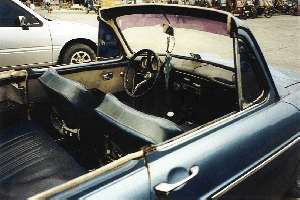© NELE STRÖBEL |
reparaturen der welt -
|
 |
Introduction:
|
||
| Claude Lévy-Strauss' conceptual model of "wild thinking" is more modern than ever. Modern myths are constantly being created by fusing animated simulations of the most recent scientific events with old myths - as we see in the cyberspace texts of Rötzer, Virilio, Flusser, and others. This reception circles around the phenomenology of fascination, but is not involved with itself. These myths warn against the loss of primary experience or discuss a world which most adults barely know. What's missing is a description of the mythological power which makes the world of the cyborgs so desirable and fascinating because it foreshadows the end of the traditional man-machine boundary - and simultaneously creates a parallel world where young people today live. This world is characterized by strong feelings and fantasies about changing and expanding man's basic biological configuration. Humans can be upgraded in any conceivable fashion and be rebuilt using the most progressive technical features available. They can fashion themselves into super-beings or be completely manipulated and instrumentalized by higher powers. But are these changes really so complex that they should take on the aura of modern myth? | ||
 It is a fact that the boundaries between men and machines are
slowly disintegrating. People spend ever more time with machines,
which are becoming increasingly intelligent and demanding. Because
they are programmed by humans, they almost "behave" like humans
with all their illogicality, quirkiness, and faults. We perceive
them to be living beings which we must relate to with emotional
intelligence. Machines learn according to their own rules and often
impose these on us. The fragmentation of experience and knowledge
triggers the notion that certain necessities - which are too tiring
or boring for us to acquire the hard way - could be remediated by
the implantation of knowledge. For many, the result is life in the
fast lane - those in the know, the avant garde of the knowledge
society rearm themselves, transforming themselves into even more
high-performance beings. It is a fact that the boundaries between men and machines are
slowly disintegrating. People spend ever more time with machines,
which are becoming increasingly intelligent and demanding. Because
they are programmed by humans, they almost "behave" like humans
with all their illogicality, quirkiness, and faults. We perceive
them to be living beings which we must relate to with emotional
intelligence. Machines learn according to their own rules and often
impose these on us. The fragmentation of experience and knowledge
triggers the notion that certain necessities - which are too tiring
or boring for us to acquire the hard way - could be remediated by
the implantation of knowledge. For many, the result is life in the
fast lane - those in the know, the avant garde of the knowledge
society rearm themselves, transforming themselves into even more
high-performance beings. |
||
 This model
of the virtual world clearly shows that gene technology puts humans
in danger of solely becoming objects in need of repair. People are
constantly more invulnerable, have eternal life - but then what?
Does restoration or repair still have any value? Is there any more
need for creativity? What are the ethical criteria for technically
improving man? The increasing blurriness of the man-machine
boundary creates many controversial questions: What are the ethical
consequences of these technological possibilities? What is so
fascinating about this perspective? Does it benefit us
technologically? In light of the "new animism" sparked by
artificial intelligence (computers have feelings, become housepets
or even lovers), we can rightly ask ourselves: What entertainment
and awareness does life in the cyborg world offer that the real
world doesn't? This model
of the virtual world clearly shows that gene technology puts humans
in danger of solely becoming objects in need of repair. People are
constantly more invulnerable, have eternal life - but then what?
Does restoration or repair still have any value? Is there any more
need for creativity? What are the ethical criteria for technically
improving man? The increasing blurriness of the man-machine
boundary creates many controversial questions: What are the ethical
consequences of these technological possibilities? What is so
fascinating about this perspective? Does it benefit us
technologically? In light of the "new animism" sparked by
artificial intelligence (computers have feelings, become housepets
or even lovers), we can rightly ask ourselves: What entertainment
and awareness does life in the cyborg world offer that the real
world doesn't? |
||
 In this
context, repair and restoration can be seen as universal processes
and activities carried out by people in the widest range of
professions. Twenty-two representatives of science, economics,
culture, and politics were willing to reflect on aspects of repair
in their fields, giving rise to a kaleidoscopic collection of texts
which guides the reader through many disciplines as well as through
the exhibition, and which has turned the centrally located
Maximiliansforum into a workshop and think tank. In this manner,
the underground city rooms become a temporary artistic and
communicative laboratory where reparaturen der
welt (repairing the world) can be visualized in its many
facets. In this
context, repair and restoration can be seen as universal processes
and activities carried out by people in the widest range of
professions. Twenty-two representatives of science, economics,
culture, and politics were willing to reflect on aspects of repair
in their fields, giving rise to a kaleidoscopic collection of texts
which guides the reader through many disciplines as well as through
the exhibition, and which has turned the centrally located
Maximiliansforum into a workshop and think tank. In this manner,
the underground city rooms become a temporary artistic and
communicative laboratory where reparaturen der
welt (repairing the world) can be visualized in its many
facets. |
||
| The exhibition's thematic rooms complement each
other: Room a) Room b) |
||